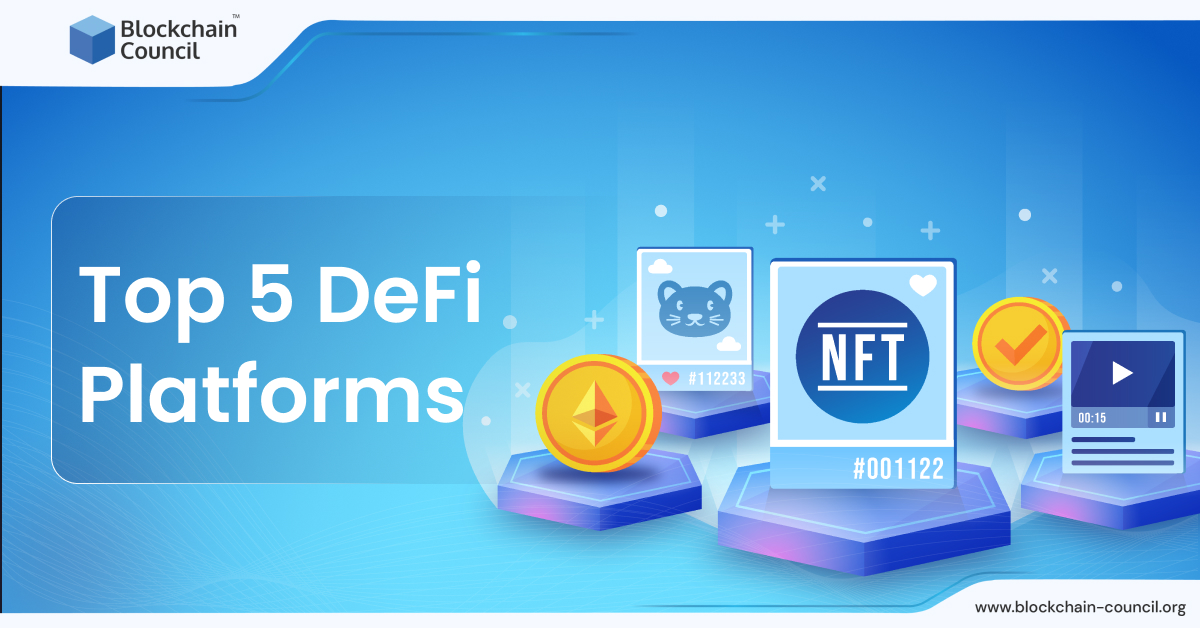
- Blockchain Council
- October 27, 2023
Summary
- DeFi, or Decentralized Finance, has grown dramatically, with a Total Value Locked (TVL) of $51.5 billion as of 2023, representing a 6,900% increase since 2020.
- Key elements of DeFi platforms include smart contracts, tokenization, liquidity pools, decentralized exchanges, yield farming, and governance tokens.
- DeFi can be compared to a traditional bank but operates as a decentralized vault, enabling users to deposit and access funds without a central authority.
- DeFi platforms often require collateral for loans, and failure to repay results in collateral being used to compensate lenders.
- The top 5 DeFi platforms are Uniswap, Aave, MakerDAO, Compound, and Yearn Finance.
- Uniswap is a decentralized exchange on Ethereum with its native governance token, UNI.
- Aave is a decentralized lending platform that operates across multiple chains and is governed by its users through AAVE tokens.
- MakerDAO offers a stablecoin, DAI, and operates as a decentralized ecosystem governed by MKR token holders.
- Compound is a decentralized lending and borrowing platform on Ethereum that uses smart contracts and blockchain technology to create an open financial ecosystem.
- Yearn Finance, represented by YFI, is a community-driven platform on Ethereum that uses automated trading strategies to optimize crypto earnings.
Introduction
DeFi, short for Decentralized Finance, has reshaped the way we interact with our finances. In this dynamic landscape, the Total Value Locked (TVL) has surged to an astounding $51.5 billion. DeFi TVL has grown by more than 6,900% since 2020, signifying the exponential growth this space has witnessed. As of 2023, unique DeFi users have surged by 40%, making it evident that DeFi is no longer an exclusive club; it’s open to all. Whether you’re a novice or an expert, navigating the world of DeFi can be a rewarding journey. In this article, we’ll delve into the 5 best DeFi platforms that offer a plethora of opportunities.
What is a DeFi Platform?
A DeFi platform, short for Decentralized Finance, is where financial services go digital, eliminating intermediaries. These platforms rely on blockchain technology for secure, transparent transactions.
Key Elements of DeFi Platforms
| Smart Contracts |
| Tokenization |
| Liquidity Pools |
| Decentralized Exchanges |
| Yield Farming |
| Governance Tokens |
- Smart Contracts: DeFi platforms use self-executing contracts, automating processes without middlemen.
- Tokenization: Assets become digital tokens, allowing fractional ownership and liquidity.
- Liquidity Pools: Users contribute funds for trading, earning fees and rewards.
- Decentralized Exchanges (DEX): These enable peer-to-peer trading, cutting out traditional exchanges.
- Yield Farming: Users stake or lend their assets for interest and rewards.
- Governance Tokens: Users often have a say in platform decisions through these tokens.
To help you grasp the concept of DeFi, consider this analogy:
Think of a traditional bank as a heavily fortified vault filled with money, tightly controlled by the bank itself. To borrow money from the bank, you must undergo a rigorous credit check and formalize a loan agreement.
Now, picture a DeFi application as a decentralized vault. Anyone can deposit funds into this vault, and anyone can access funds from it. No central authority governs the vault, and all transactions are transparently recorded on the blockchain.
To obtain a loan from a DeFi vault, you simply deposit collateral, which can be in the form of cryptocurrency or stocks. If you fail to repay the loan, the collateral serves as a guarantee to compensate the lenders.
DeFi has the potential to revolutionize finance by making services more accessible, transparent, and secure. However, it’s important to acknowledge that DeFi is still an emerging field, and it carries inherent risks.
Top 5 DeFi Platforms
Uniswap
At its core, Uniswap is a decentralized exchange (DEX) operating within the Ethereum blockchain. It is a place where you can trade cryptocurrencies without the need for a middleman. No more waiting for approvals or surrendering control of your assets. Uniswap empowers you with direct, peer-to-peer trading, putting the reins back in your hands. But there’s more to Uniswap than just trading.
UNI, Uniswap’s native governance token, is a force to be reckoned with. Holding UNI means holding power. It allows you to actively shape the future of Uniswap by voting on key protocol changes and development initiatives. Since its inception in November 2018, Uniswap has paved the way for the DeFi revolution. It pioneered the Automated Market Maker (AMM) model, which is a breath of fresh air compared to traditional order book systems. Here, the liquidity pools and algorithms set market prices, driven by supply and demand, making the process seamless and efficient.
Back in September 2020, Uniswap dropped a surprise in the DeFi world by distributing 400 UNI tokens to every Ethereum address that had ever used the platform. This novel “airdrop” approach, rewarding loyal users, demonstrated Uniswap’s commitment to its community. While the majority of crypto trading happens on centralized exchanges like Coinbase and Binance, Uniswap’s decentralized approach has struck a chord with those who value control and autonomy over their assets. Uniswap’s AMM system, automated liquidity pools, and commitment to decentralization have propelled it to the forefront of DeFi.
Unique Features
- Concentrated Liquidity: Uniswap v3 brings a game-changer with its concentrated liquidity feature. Liquidity providers can now focus their assets within a specific price range, enhancing capital efficiency and reducing transaction fees. This empowers users to optimize their liquidity for maximum impact.
- Oracle Feed Developments: Uniswap v3 doesn’t just stop at liquidity management; it also enhances its security and reliability through new oracle feed developments. These feed improvements provide up-to-the-minute data, ensuring accurate and trustworthy market information.
- Range Orders: Uniswap v3 introduces the concept of range orders. This feature allows users to specify a price range for executing trades, effectively minimizing slippage. Range orders cater to traders who demand precision in their transactions, offering a tool to execute orders with minimal price impact.
- Non-Fungible Liquidity (NFTs): Uniswap v3 presents an innovative addition with non-fungible liquidity (NFTs). Liquidity providers now have the freedom to create and manage their own unique liquidity pools. This empowers providers with flexibility and control over their assets, opening doors to a more personalized DeFi experience.
- Licensing Freedom: Uniswap operates under the Business Source License (BSL), which is a permissive open-source license. This means that Uniswap’s code is accessible to all, and users have the liberty to modify, use, and distribute it for any purpose, even for commercial endeavors. Uniswap’s commitment to open-source values ensures that the platform remains a beacon of accessibility and innovation in the DeFi landscape.
Aave
Aave is a decentralized lending platform that empowers users to lend, borrow, and earn interest on a wide array of crypto assets. Gone are the days of intermediaries and traditional banks. Aave disrupts the conventional financial landscape, putting the power back in the hands of the people. Now, you might wonder, what sets Aave apart from the crowd?
One word: innovation. Aave’s journey began atop the Ethereum network, pioneering the use of ERC20 tokens to process transactions. But Aave didn’t stop there; it expanded to other chains, including Avalanche, Fantom, and Harmony. This multi-chain approach enhances accessibility and ensures Aave remains at the forefront of DeFi evolution.
Here’s the real game-changer: Aave operates as a decentralized autonomous organization (DAO). In simple terms, it’s governed by its users, particularly those who hold and vote with AAVE tokens. This means your voice matters, and you have a say in the protocol’s direction.
Aave’s lending system differs significantly from traditional finance. Aave replaces the need for banks with smart contracts, enabling you to borrow cryptocurrency from peers. However, you still need to put up collateral, typically in the form of other cryptocurrencies, given the volatility of the market. However, Aave’s offering extends beyond just cryptocurrencies; it has pools for real-world assets like real estate, cargo and freight invoices, and payment advances. Partnering with Centrifuge, Aave helps brick-and-mortar businesses tokenize their operations, offering investors the chance to earn yields, much like bonds. These assets can then be used as collateral for businesses to borrow cash, expanding the horizon of DeFi.
In March 2022, it launched v3, introducing the game-changing Portal feature, allowing seamless operation across all blockchains. Now you can participate in lending or borrowing on various chains, expanding the possibilities of DeFi.
Unique Features
- Flash Loans: Aave’s standout feature, flash loans, redefine the lending experience. Users can borrow and repay assets in a single transaction, making it ideal for activities like arbitrage, collateral swapping, and self-liquidation. Flash loans are instant and permissionless, enabling anyone to utilize them without complex credit checks.
- Interest Rate Switching: Aave empowers users to seamlessly switch between fixed and variable interest rates for their loans and deposits. This flexibility enables users to optimize their earnings and manage risk according to prevailing market conditions.
- Wide Asset Support: Aave boasts a diverse selection of supported crypto assets, including stablecoins, governance tokens, and NFTs. This extensive asset coverage makes it a versatile platform suitable for both lenders and borrowers, catering to a broad spectrum of financial preferences.
- Decentralized Governance: Aave operates as a decentralized protocol, meaning it’s governed by its community of users. This governance structure relies on the AAVE token, enabling token holders to actively participate in voting on proposals and protocol changes. Aave’s users have a real say in the platform’s evolution.
- High Liquidity: Aave’s liquidity pools are among the most substantial in the DeFi space. This translates to high liquidity, making it exceptionally convenient for users to swiftly borrow and lend assets. Aave’s liquidity pool offers the ease and efficiency that DeFi enthusiasts and professionals desire.
MakerDAO
MakerDAO isn’t merely a lending platform. It’s a financial ecosystem that empowers you to take control of your assets. At its heart lies DAI, a stablecoin pegged to the US dollar. This stablecoin is your gateway to a world where the wild price swings of cryptocurrencies are tamed, providing a sense of security rarely found in the digital financial landscape.
So, how does MakerDAO work? At its core, MakerDAO allows you to lock up your digital assets, such as Ethereum, in smart contracts on the Ethereum blockchain. In return, you can generate DAI, the stablecoin. The more assets you lock up, the more DAI you can create. It’s a simple concept with profound implications. MakerDAO is also a self-sustaining ecosystem. The system ensures that DAI maintains its value, one US dollar at a time. When you create DAI, it becomes your borrowing and payment mechanism within the MakerDAO ecosystem.
One of the most remarkable aspects of MakerDAO is its decentralized governance model. Unlike traditional financial institutions, MakerDAO’s decisions are made by the community of MKR token holders. This means that you have a say in how the system operates. Your MKR tokens represent your voice in shaping the future of MakerDAO.
Additionally, MakerDAO’s stability is maintained through a process known as liquidation. If the value of your collateral drops below a certain threshold, your assets are liquidated to cover your outstanding DAI debt. This self-correcting mechanism ensures the system’s stability, preventing it from becoming over-leveraged. Furthermore, MakerDAO’s ecosystem is composable, meaning it integrates seamlessly with other DeFi projects. This interconnectedness allows developers to build on top of MakerDAO’s infrastructure, increasing its functionality and usability.
Unique Features
- Decentralized Stability: MakerDAO’s hallmark feature is its stablecoin, Dai. Unlike many cryptocurrencies prone to wild price fluctuations, Dai is tethered to the US dollar and supported by a collateral pool of various cryptocurrencies. This fundamental underpinning ensures a level of stability and predictability often missing in the crypto space.
- Community-Led Governance: MakerDAO operates under the purview of a decentralized autonomous organization (DAO), where ownership and operation are in the hands of community members. This structure fosters transparency and accountability, setting it apart from conventional financial institutions.
- Open-Source Assurance: MakerDAO’s code is open-source, inviting scrutiny and contributions from anyone. This open nature enhances security and reliability, mitigating the risks associated with closed-source platforms.
- Constant Innovation: MakerDAO is at the forefront of innovation, continuously adding new features to its platform. An excellent example is the recently introduced Dai Savings Rate, offering users the opportunity to earn interest on their Dai deposits.
- Maker Vaults: These smart contracts are a bonus feature that further amplifies MakerDAO’s utility. Maker Vaults enable users to create and manage collateralized loans. By depositing various cryptocurrencies into a Maker Vault, users can borrow Dai against their collateral, providing a convenient liquidity solution without the need to sell their crypto assets.
Compound
Compound, at its core, is a decentralized lending and borrowing platform running on the Ethereum blockchain. It’s like a digital lending marketplace, but with a twist. Instead of relying on traditional banks, Compound leverages smart contracts and blockchain technology to create an open financial ecosystem.
Now, let’s dive into the nitty-gritty of how Compound operates. Users can lend their cryptocurrencies to the platform, contributing to what we call liquidity pools. In return, they receive interest on the assets they’ve deposited. It’s akin to depositing money in a savings account, except your funds become part of a digital pool, earning interest as they work for you.
But that’s only half the story. Compound empowers borrowers as well. Anyone can post collateral in the form of cryptocurrency and take out a loan in a different crypto asset supported by Compound. This overcollateralized system ensures the safety of the platform, as borrowers are responsible for repaying their loans to maintain their collateral. It’s a simple but elegant mechanism that keeps the system balanced.
One of the highlights of Compound is its cTokens. These are tokens that represent your deposits on the platform. For example, if you deposit Ethereum (ETH), you receive cETH. These cTokens are transferrable, which means you can trade them at your convenience. However, their real power shines when you want to redeem your original cryptocurrency. You can exchange your cTokens for the underlying asset whenever you desire, all thanks to the automatic workings of the Compound code.
Now, let’s talk about the catalyst that keeps the Compound ecosystem thriving – COMP tokens. These native tokens are the lifeblood of the platform. Every time users interact with Compound, whether by borrowing, lending, or repaying assets, they are rewarded with COMP tokens. These tokens are like a digital pat on the back, an incentive for active participation within the Compound community.
But COMP tokens are not just rewards; they’re also governance tokens. Holders of COMP tokens get a say in the decisions that shape the future of the platform. It’s a democratic process; each COMP token equals one vote. Even if you’re not a COMP holder, you can delegate your voting rights to someone you trust. This ensures that important decisions are made collectively, by those who are deeply involved in the system.
Unique Features
- Earn Interest on Your Crypto Assets: Compound offers a simple and effective way to grow your crypto holdings. By depositing your assets into liquidity pools, you become a part of a lending ecosystem. When borrowers utilize these funds, you earn a portion of the interest they pay on their loans. It’s like putting your crypto assets to work for you.
- Borrow Crypto Assets without Collateral: One standout feature of Compound is its risk-based pricing model. This means that users with a lower risk profile can borrow crypto assets without the need for collateral. The interest rates for borrowers are determined by their risk level, making DeFi lending more accessible and flexible.
- Open Source and Transparent: Transparency is at the core of Compound’s ethos. Being an open-source protocol, anyone can view and contribute to the code. This level of openness fosters accountability and trust, setting Compound apart from many other DeFi platforms.
- Algorithmic Interest Rates: Compound employs a sophisticated algorithmic interest rate model to determine the interest rates for borrowers and the returns for depositors. This model factors in various elements, including the supply and demand of crypto assets within the liquidity pools, ensuring that interest rates remain competitive and fair.
- Integration with Other DeFi Platforms: Compound isn’t an isolated island. It’s seamlessly integrated with other leading DeFi platforms like Uniswap and Aave. This interoperability allows users to move their crypto assets across different DeFi platforms, creating a comprehensive ecosystem for decentralized finance.
Yearn Finance
Yearn Finance, often abbreviated as YFI, is a decentralized platform on the Ethereum blockchain designed to optimize your crypto earnings. But it’s more than just a platform; it’s a community-driven force of financial innovation.
Yearn Finance introduces “money robots,” which are essentially automated trading strategies executed across various DeFi platforms. These robots, designed by Yearn, are your trusty companions on a journey to maximize returns. They can perform a myriad of tasks, from earning trading fees on platforms like Curve to borrowing funds through Aave’s flash loans and lending assets to Compound.
The crown jewels of Yearn Finance are the yVaults. These are a series of token pools, each following a distinct investment strategy across various DeFi platforms. When you deposit your assets into a yVault, you receive yTokens in return. For example, you can deposit GUSD into the GUSD yVault and get yGUSD tokens in return. When you decide to redeem your yGUSD, you not only get back your original GUSD but also any earnings or rewards your GUSD accumulated while working in the yVault.
Now, let’s talk strategy. Yearn Finance’s yVault strategies are dynamic, subject to change as the community decides to optimize returns. Take the yGUSD strategy in October 2020 as an example. This strategy involved steps like depositing GUSD into a Curve pool of stablecoins, staking LP tokens to earn CRV, selling CRV for DAI, and so on. The more complex strategies, like the yETH vault, delve into borrowing, leverage, and exposure to market forces. Here, ETH is deposited to MakerDAO as collateral, DAI is borrowed from MakerDAO, and the journey continues to maximize yield.
However, remember, the more complex the strategy, the greater the risks. Yearn’s strategies grow in complexity as they involve more protocols and platforms, introducing risks like liquidation and smart contract failures. Yearn Finance’s offerings go beyond yVaults. The Yearn suite includes applications like yEarn, Zap, yInsure, and many others. These applications cater to different aspects of DeFi, from lending stablecoins to automating transactions and providing insurance for smart contracts. Yearn Finance is a unique experiment in automated investing and product development, driven by the wisdom of the crowd. Anyone can propose a new strategy on the Yearn governance forum, and if the community approves it, the strategy creator earns fees.
Unique Features
- Yield Aggregation: Yearn Finance is a hub for DeFi protocols like Aave, Curve, and Compound. It continuously scans for the highest yields in the market and automatically reallocates your assets to these platforms. This dynamic approach ensures you’re always earning the most.
- Automated Yield Farming: Yearn’s “vaults” simplify yield farming. These vaults handle the intricate aspects of yield farming for you. Your funds are automatically invested in the most profitable strategies, and the vaults frequently adjust your portfolio to maximize returns.
- Asset Dimension Optimization: Diversification is the key to risk management. Yearn Finance helps you spread your assets across various asset classes and protocols. This minimizes the impact of any single event on your overall portfolio, making it more resilient.
- Insurance: Safety matters. Yearn Finance offers insurance on its vaults through partnerships with other DeFi protocols. This acts as a safeguard, protecting your investments in the event of hacks or unforeseen crises.
- Dynamic Fees: Yearn Finance employs a unique fee model. It charges lower fees when the platform generates higher yields. This incentivizes users to deposit funds when the platform is most profitable, creating a win-win situation.
Things to Remember Before Choosing the Best DeFi Platform
| Consideration | Description |
| Security | Check the platform’s security measures, like audits and insurance, to protect your assets. |
| Liquidity and Tokens | Ensure there’s enough liquidity and a variety of tokens available for your needs. |
| User Interface | User-friendly interface makes it easier to navigate and trade without complications. |
| Fees and Costs | Understand all fees involved, including transaction fees, gas fees, and staking costs. |
| Team and Transparency | Research the development team and look for transparency in the platform’s operations. |
| Community Support | A strong and active community often indicates the platform’s reliability and support. |
Conclusion
In conclusion, DeFi is not just a buzzword; it’s a financial revolution that empowers you to take control of your assets. The five platforms we’ve discussed offer unique features, and with the cumulative DeFi revenue growing from $3.7 billion at the beginning of 2022 to a staggering $5.22 billion by the end of the year, it’s clear that the DeFi ecosystem is booming.
Further. decentralized exchanges executed a jaw-dropping $854 billion in trading volume in 2022, indicating the immense trading opportunities available. What’s even more impressive is that the average DeFi user generated $2,026 in revenue in 2023. Your financial future is in your hands, and with this article as your guide, you can make the most of the decentralized financial ecosystem.
FAQs
Which DeFi platform is best?
- The “best” DeFi platform can vary depending on individual preferences and needs.
- However, some popular DeFi platforms include Uniswap, Aave, MakerDAO, Compound, and Yearn Finance.
- The choice depends on your specific use case and requirements.
What are the biggest DeFi platforms?
- Some of the biggest and most prominent DeFi platforms include Uniswap, Aave, MakerDAO, Compound, and Yearn Finance.
- These platforms have significant Total Value Locked (TVL) and widespread recognition in the DeFi space.
Which is the best DeFi project?
- The “best” DeFi project is subjective and can depend on what you’re looking to achieve.
- Each DeFi project offers unique features and caters to different needs.
- It’s advisable to research and select the one that aligns with your specific financial goals and preferences.
Is DeFi the future?
- DeFi, or Decentralized Finance, is considered by many to be a significant part of the future of finance.
- It has the potential to make financial services more accessible, transparent, and secure.
- However, it’s essential to acknowledge that DeFi is still an emerging field and carries inherent risks.
- Its growth and impact on traditional finance are subjects of ongoing exploration and development.
What is a DeFi platform?
- A DeFi platform, short for Decentralized Finance platform, is where financial services are digitized and decentralized, eliminating the need for traditional intermediaries like banks.
- These platforms rely on blockchain technology to facilitate secure and transparent financial transactions.
- Key elements of DeFi platforms include smart contracts, tokenization, liquidity pools, decentralized exchanges (DEX), yield farming, and governance tokens.

































































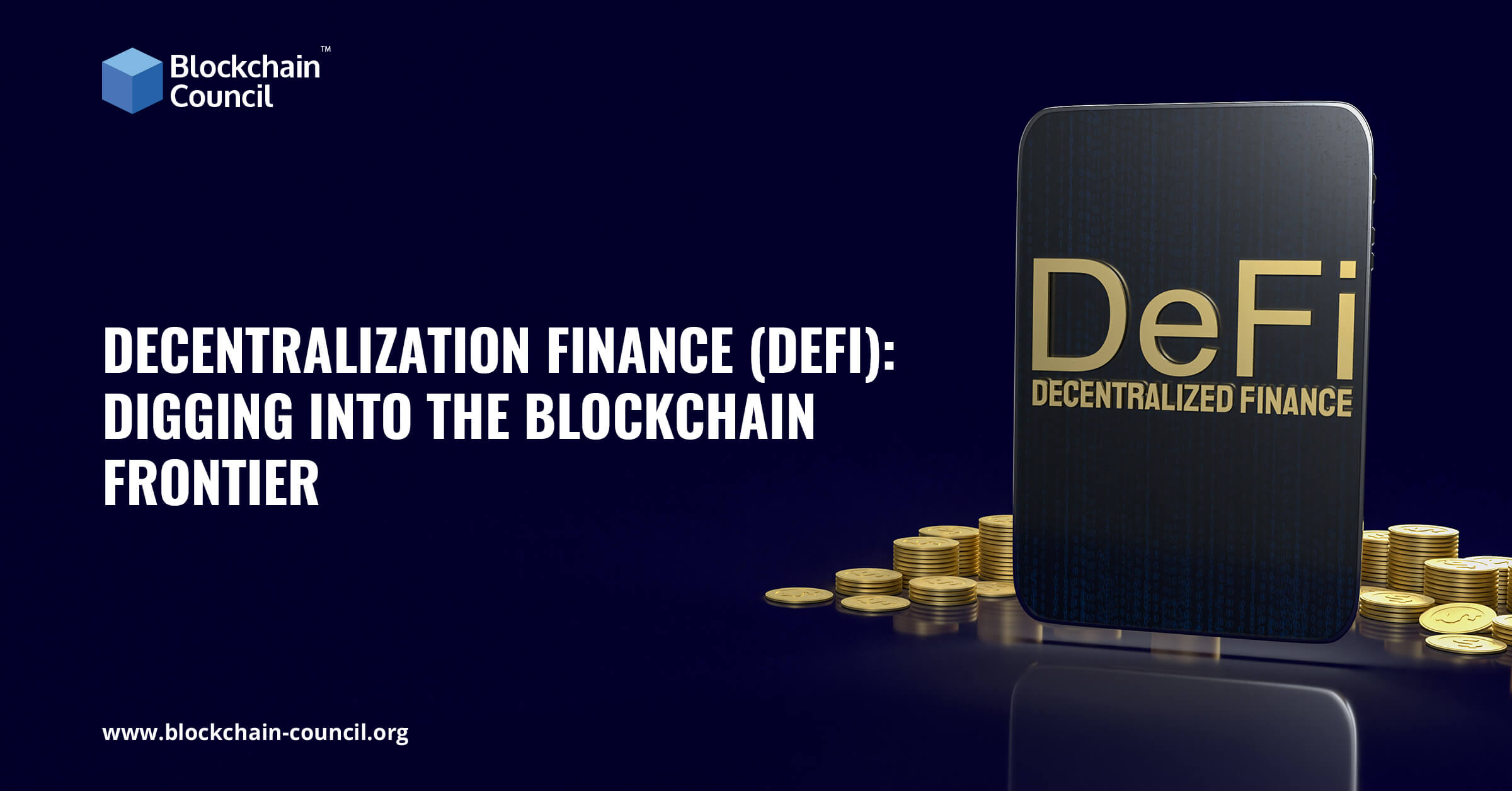
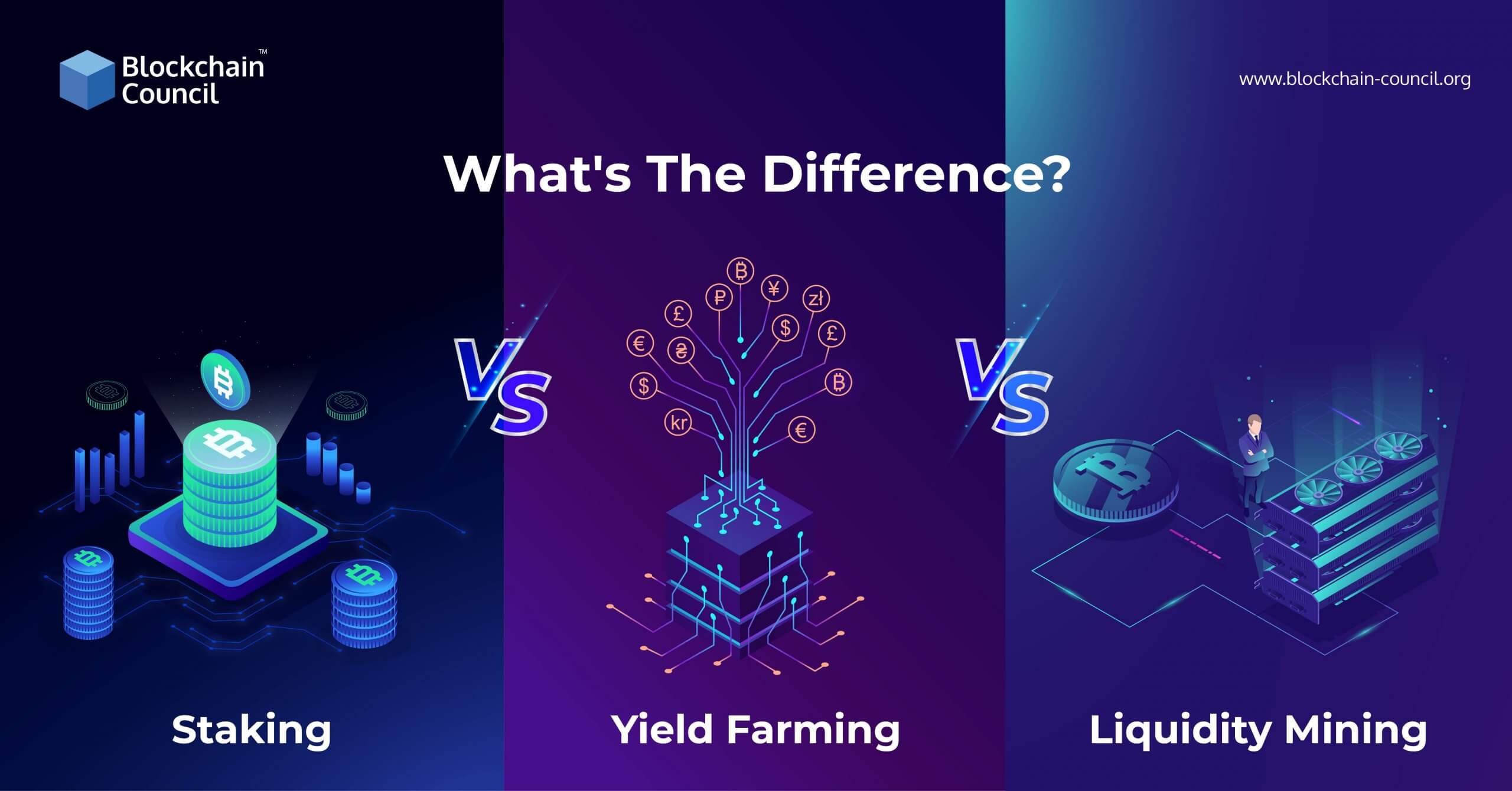
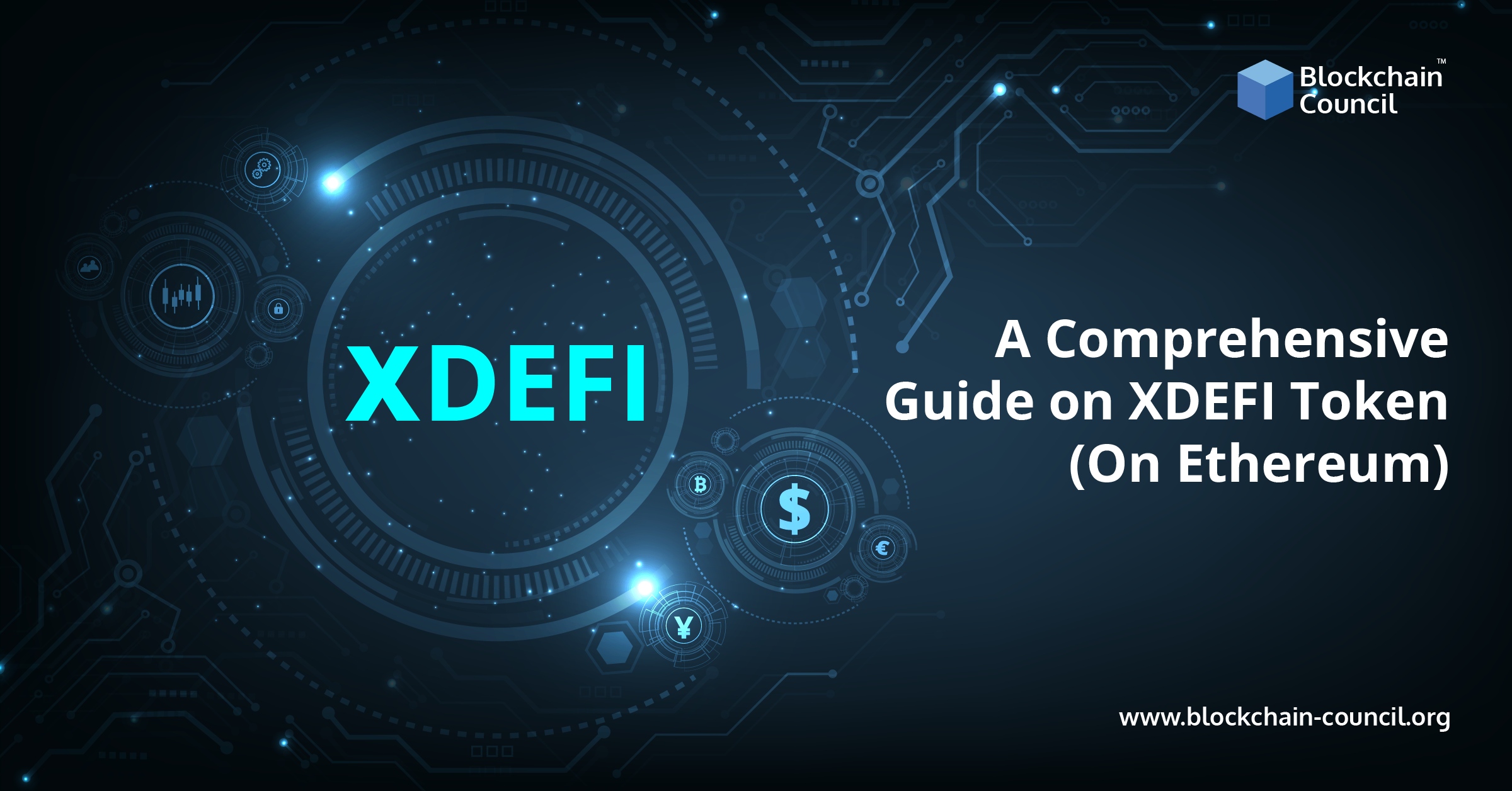
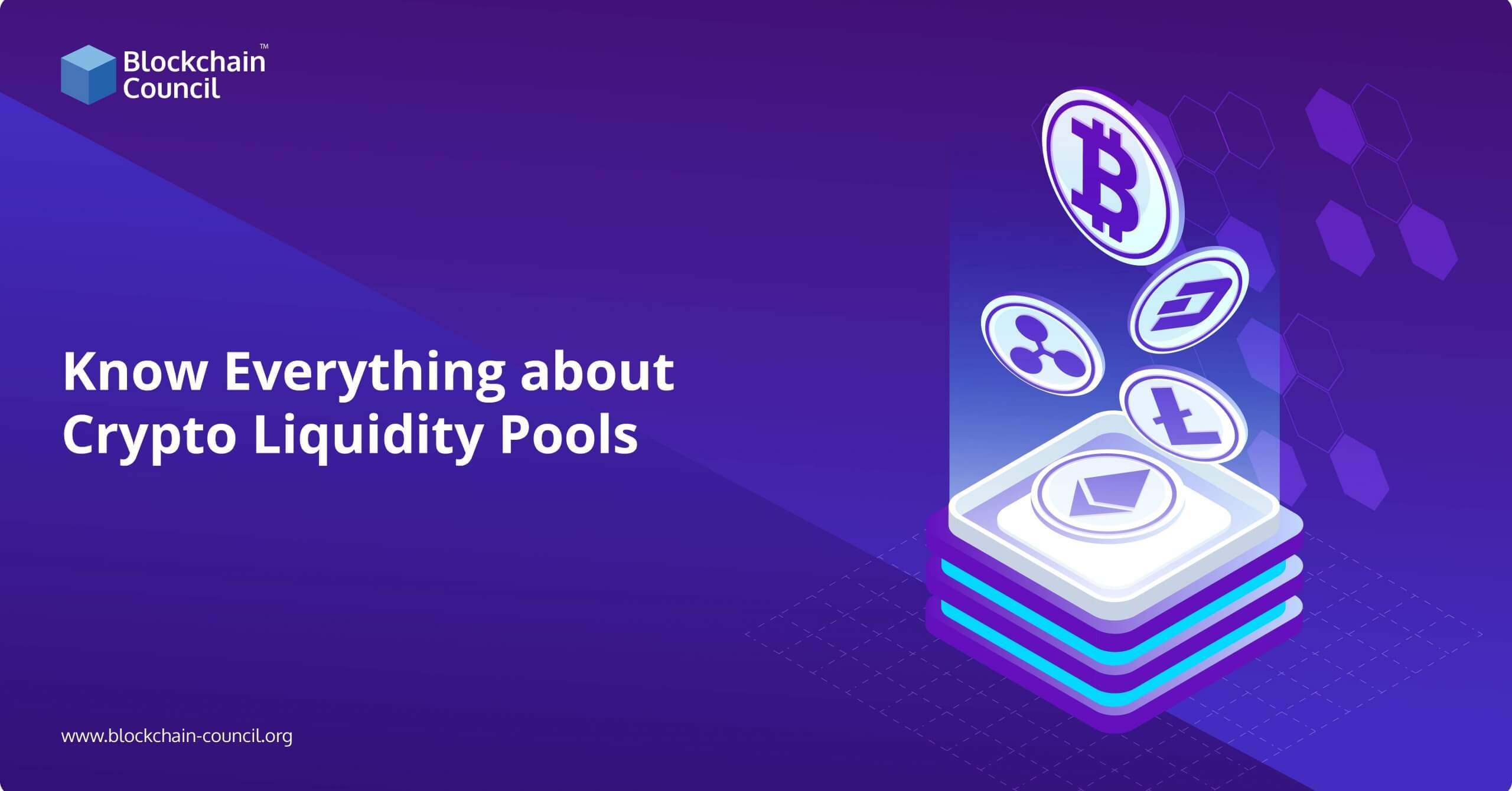
 Guides
Guides News
News Blockchain
Blockchain Cryptocurrency
& Digital Assets
Cryptocurrency
& Digital Assets Web3
Web3 Metaverse & NFTs
Metaverse & NFTs
